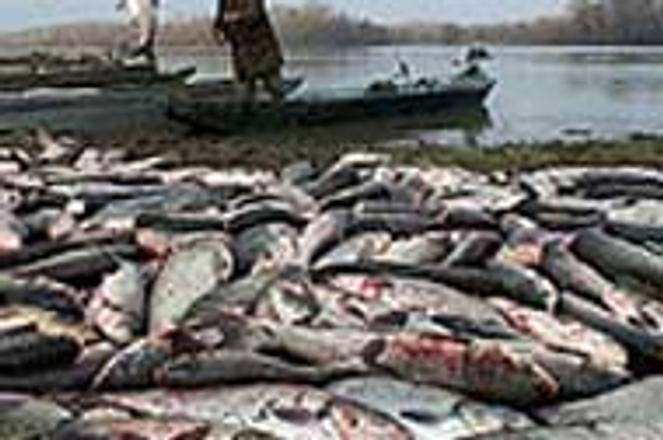Dubbed the greatest European environmental disaster after Chernobyl, a recent cyanide spill in Romania has killed river life across the region.photo: Reuters
The accidental release of 100,000 cubic metres of cyanide-polluted water from a waste-water reservoir in Romania on January 30 has contaminated rivers in Slovakia, Hungary and Serbia. In what is being called the biggest European environmental catastrophe since the meltdown of the Chernobyl nuclear power plant in Ukraine in 1986, the poisonous tide has left 'a complete loss of river life' in its wake, ruined the livelihoods of regional fisheries and forced thousands of Hungarian citizens to seek alternative sources of drinking water.
The waste-water reservoir in the Romanian town of Baia Mare is home to the Australian gold-mining firm Aurel. CEO Philip J. Evers, who quit after the spill, said that bad weather was to blame for the accident. Evers told the Hungarian daily Nepszava that torrential rainfall at the end of January had swelled the reservoir until it overflowed into the Lapos River, a tributary of the River Szamos. The waste poured into the river for three days before authorities could finally stop the flow.
On February 4 the spill flowed into the Tisza River in Hungary, which for six kilometres forms the border between south-eastern Slovakia and north-eastern Hungary. Measurements of the river's cyanide levels revealed that the Slovak stretch of the Tisza was carrying 1.16 milligrams per litre (mpl) of cyanide, almost six times the 0.2 mpl maximum level allowed in Slovakia. The waste then flowed down the Tisza where it entered the Danube in southern Hungary.
"The [Slovak stretch of the Tisza] river is 100% dead," said Janos Bogoly, an environmental journalist for regional Slovak and Hungarian newspapers.
"Everything - including the fish, the birds who feed on them, the fauna, even the river bacteria - is dead."
The Hungarian news agency MTI reported on February 9 that the 80,000 residents of the city of Szolnok in central-eastern Hungary had been forced to seek alternative water sources until cyanide levels in the Tisza fell below 2.0 mpl.
Milan Matuška, the Slovak Environment Ministry's Director of Water Management, termed the damage "extreme", and added that due to ageing, low-quality technology, similar environmental time-bombs were waiting to explode in other poor countries of central and eastern Europe.
"In countries like Ukraine and Romania, where the economy is bad, the infrastructure is weak and the equipment is old, you cannot say that nothing will happen in the future," Matuška told The Slovak Spectator February 15. "We can not rely on the possibility that no more problems will occur. That would be unrealistic."
Regional co-operation
The serious cross-border implications of domestic environmental disasters make regional co-operation and communication all the more important, Matuška said. Neighbouring Ukraine is a country of particular concern, he continued, because of their low-quality technology coupled with Slovakia's limited knowledge of the country's internal environmental operations.
"We have information on what industries are a high risk [in Ukraine]," he said. "But we are not as well informed about the exact situation in those areas as we are in Hungary - and we have no fear that this kind of disaster could happen in Hungary."
Matuška added that Hungary and Slovakia had had no problems in conducting a joint emergency response to the Romanian spill. However, the Slovak press agency SITA reported on February 4 that Slovakia had been given wrong information concerning the arrival of the cyanide. According to water checks on the river, the contaminated wave arrived over 24 hours before the Hungarians had predicted it would. Viliam Vološ of the Slovak river management authority Povodie Hornádu a Bodrogu said that the wave took six to eight hours to pass.
Romanian Deputy Foreign Minister Mihai-Razvan Ungureanu also said that better channels of communication should be established. Ungureanu said on February 9 that the disaster had been a "warning" that Hungarian-Romanian co-operation, which he called "good" in all other areas, should be extended to environmental protection as well.
Long-term implications
As citizens along the poisoned shores of the Szamos, Tisza, and Danube rivers pull the dead wildlife out of the water - over 40 tonnes of dead fish have been removed from waters in the northern Hungarian town of Tiszalok alone - experts are trying to assess the long-term damage the cyanide may cause.
Although Slovak officials said it would be at least a month before a comprehensive evaluation could be made, Vološ said it was clear that Slovakia had escaped with far less damage than Hungary.
"Slovakia was very lucky," he said. "Only six kilometres of our territory were affected." He added that the 1.16 mpl readings in Slovakia were far lower than the 3.7 mpl readings found throughout Hungary. Fish are unable to survive cyanide water levels higher than 0.5 mpl.
Bogoly, for his part, said the recovery would take years. "The river will be contaminated for a minimum of 2 to 3 years, but it could be as long as 10 years," he said. "This stretch of the river has always been famous for its lush spring bloom, but we certainly will not see it this year."
Additional reporting
by Martina Pisárová


